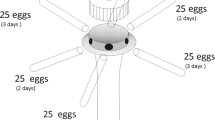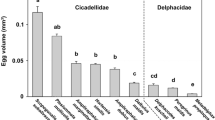Abstract
The frequency of encapsulation of eggs ofAnagyrus pseudococci (Girault) (Hymenoptera: Encyrtidae) by four mealybug species:Planococcus citri (Risso),PL vovae (Nasonov),Pl. ficus (Signoret) andPseudococcus cryptus Hempel (=citriculus Green), was studied under controlled laboratory conditions. The aggregate percentage of encapsulated eggs (AE) and the percentage of efficient encapsulation (EE) (= percent parasitized mealybugs wherein encapsulation prevented the development of all parasitoid larvae) byPl. citri andPl. vovae did not differ significantly (39.0%vs 38.2% AE and 15.4%vs 17.6% EE, respectively), but was significantly higher than inPs. cryptus (16.2% AE and 5.4% EE). Encapsulation byPl. vovae was significantly higher than byPl. ficus (38.2%vs 20.1% AE and 17.6% vs 7.7% EE, respectively). Neither the host plant nor the rearing temperature significantly affected the incidence of parasitoid encapsulation. It is suggested thatA. pseudococci displays a relatively low physiological adaptation toPl. citri; thus, in a citrus grove, for example,ca 40% of the parasitoid eggs might be lost due to encapsulation. The question of a possible association between encapsulation and host—parasitoid relationships among the mealybugs studied andA. pseudococci, is discussed.
Similar content being viewed by others
References
Bartlett, B.R. (1978) Pseudococcidae.in: Clausen, C.P. [Ed.] Introduced Parasites and Predators of Arthropod Pests and Weeds: A World Review.U.S. Dep. Agric. Agric. Handb. 480: 137–170.
Bartlett, B.R. and Ball, J.C. (1966) The evolution of host suitability in a polyphagous parasite with special reference to the role of parasite egg encapsulation.Ann. Entomol. Soc. Am. 59: 42–45.
Ben-Dov, Y. (1972) Life history ofTetrastichus ceroplastae (Girault) (Hymenoptera: Eulophidae), a parasite of Florida wax scale,Ceroplastes floridensis Comstock (Homoptera: Coccidae) in Israel.J. Entomol. Soc. South. Afr. 35: 17–34.
Ben-Dov, Y. (1994) A Systematic Catalogue of the Mealybugs of the World (Insecta: Homoptera: Pseudococcidae and Putoidae) with Data on the Geographical Distribution, Host Plants, Biology, and Economic Importance. Intercept Ltd., Andover, UK.
Berlinger, M. (1977) The Mediterranean vine mealybug and its natural enemies in southern Israel.Phytoparasitica 5: 3–14.
Bess, H.A. (1939) Investigations on the resistance of mealybugs (Homoptera) to parasitization by internal hymenopterous parasites, with special reference to phagocytosis.Ann. Entomol. Soc. Am. 32: 189–226.
Blumberg, D. (1977) Encapsulation of parasitoid eggs in soft scales (Homoptera: Coccidae).Ecol. Entomol. 2: 185–192.
Blumberg, D. (1988) Encapsulation of eggs of the encyrtid wasp,Metaphycus swirskii, by the hemispherical scale,Saissetia coffeae: Effects of host age and rearing temperature.Entomol. Exp. Appl. 47: 95–99.
Blumberg, D. (1991) Seasonal variations in the encapsulation of eggs of the encyrtid parasitoidMetaphycus stanleyi by the pyriform scale,Protopulvinaria pyriformis. Entomol. Exp. Appl. 58: 231–237.
Blumberg, D. and DeBach, P. (1981) Effects of temperature and host age upon the encapsulation ofMetaphycus stanleyi andMetaphycus helvolus eggs by brown soft scaleCoccus hesperidum.J. Invertebr. Pathol. 37: 73–79.
Compere, H. (1939) A second report on some miscellaneous African Encyrtidae in the British Museum.Bull. Entomol. Res. 30: 1–26.
Cox, J.M. (1989) The mealybug genusPlanococcus (Homoptera: Pseudococcidae).Bull. Br. Mus. (Nat. Hist.) Entomol. 58: 1–78.
Dijkerman, H.J. (1990) Suitability of eightYponomeuta species as hosts ofDiadegma armillata.Entomol. Exp. Appl. 54: 173–180.
Giordanengo, P.L. and Nenon, J.P. (1990) Melanization and encapsulation of eggs and larvae ofEpidinocarsis lopezi by its hostPhenacoccus manihoti; effects of superparasitism and egg laying patterns.Entomol. Exp. Appl. 56: 155–163.
Klein, M. (1994) Studies of the citrus mealybug,Planococcus citri (Risso): Dynamics of fruit infestation and biological control. M.Sc. thesis, The Hebrew University of Jerusalem, Faculty of Agriculture, Rehovot, Israel (Hebrew, with English summary).
Mendel, Z., Blumberg, D. and Ishaaya, I. (1991) Effect of buprofezin onlcerya purchasi andPlanococcus citri.Phytoparasitica 19: 103–112.
Messenger, P.S. and van den Bosch, R. (1971) The adaptability of introduced biological control agents,in: Huffaker, C.B. [Ed.] Biological Control. Plenum Press, New York, NY. pp. 68–92.
Moore, D. (1988) Agents used for the biological control of mealybugs (Pseudococcidae).Biocontrol News Inf. 9: 209–225.
Muldrew, J.A. (1953) The natural immunity of the larch sawflyPristiphora erichsonii (Htg.) to the introduced parasiteMesoleius tenthredinis Morely, in Manitoba and Saskatchewan.Can. J. Zool. 31:313–332.
Nenon, J.P., Olivier, G. and Hemon, E. (1988) Encapsulation of eggs and larvae of the Hymenoptera EncyrtidaeEpidinocarsis (=Apoanagyrus)lopezi by its host PseudococcidaePhenacoccus manihoti: effect of temperature and superparasitism.C.R. Acad. Sci. Paris 306: 325–331.
Prinsloo, G.L. (1984) An illustrated guide to the parasitic wasps associated with citrus pests in the Republic of South Africa.S. Afr. Dep. Agric. Sci. Bull 402: 10–17.
Rivnay, E. (1968) Biological control of pests in Israel (a review 1905-1965).Isr. J. Entomol. 3: 1–56.
Rosen, D. and Rossler, Y. (1966) Studies on an Israeli strain ofAnagyrus pseudococci (Girault) (Hymenoptera: Encyrtidae). I. Morphology of the adults and developmental stages.Entomophaga 11:269–277.
Sullivan, D.J. and Neuenschwander, P. (1988) Melanization of eggs and larvae of the parasitoidEpidinocarsis lopezi (De Santis) (Hymenoptera: Encyrtidae) by the cassava mealybug,Phenacoccus manihoti Matile-Ferrero (Homoptera: Pseudococcidae).Can. Entomol. 120: 63–71.
van Driesche, R.G., Belloti, A., Herrera, C.J. and Castillo, J.A. (1986) Encapsulation rates of two encyrtid parasitoids by twoPhenacoccus spp. of cassava mealybugs in Colombia.Entomol. Exp. Appl. 42: 79–82.
Author information
Authors and Affiliations
Rights and permissions
About this article
Cite this article
Blumberg, D., Klein, M. & Mendel, Z. Response by encapsulation of four mealybug species (homoptera: pseudococcidae) to parasitization byAnagyrus pseudococci . Phytoparasitica 23, 157–163 (1995). https://doi.org/10.1007/BF02980975
Received:
Issue Date:
DOI: https://doi.org/10.1007/BF02980975




